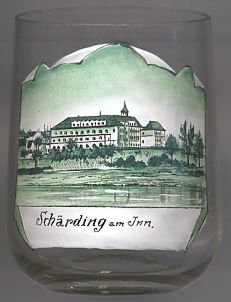

|
| ÖSTERREICH | AUSTRIA |
| Bundesland: Oberösterreich | Upper Austria |
| Bezirk: Schärding |
 Schärding is situated at an elevation of 318 m on the right bank of the river Inn, which forms the border
between Austria and Germany (Bavaria), opposite of Neuhaus a. Inn.
Schärding is the seat of the administration of the district of the same name
and has a population of about 5,000 (2001).
Schärding is situated at an elevation of 318 m on the right bank of the river Inn, which forms the border
between Austria and Germany (Bavaria), opposite of Neuhaus a. Inn.
Schärding is the seat of the administration of the district of the same name
and has a population of about 5,000 (2001).
The earliest mention of Scardinga is found in a document of AD 804 where Schärding was mentioned as an estate of the bishops of Passau. In the 10th century it became the centre of the domains of the counts of Formbach(Vornbach)-Neuburg. In 1160 it came in possession of the counts of Andechs, who were succeeded in 1248 by the Bavarian dukes of the Wittelsbacher dynasty. As it was located on an important trading route, Schärding soon prospered as a trading place for salt, wood, ores, wine, silk, glass, grains, cloth and cattle. Towards the end of the 13th century, Schärding obtained the privileges of a market town. In 1310 it was mentioned for the first time as a town, and in 1369 it obtained this status definitely. With the Treaty of Teschen (now Cieszyn), which ended the War of the Bavarian Succession between Austrian and Prussia, the Innviertel region became part of the Austrian countries and Schärding thus became a border town. In addition, the town losts its position as a salt-trading town because of the Austrian state's salt monopole. During the Napolenic wars, Schärding was devastated in 1806. In 1810 the Innviertel region was annexed again by Bavaria, but after the Congress of Vienna (1815) it was returned to Austria.
The picture on glass no. 2199 [left] shows the
 Kuranstalt
Kuranstalt
![[scale]](lineal.jpg)